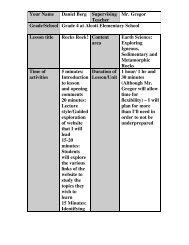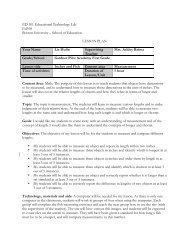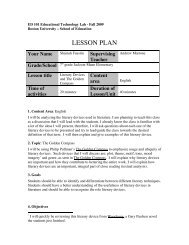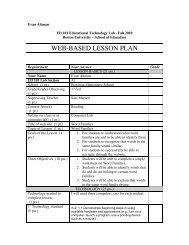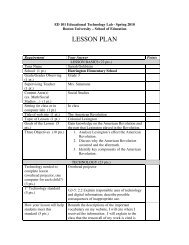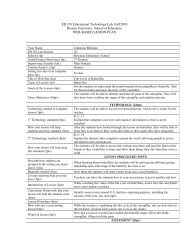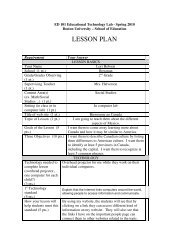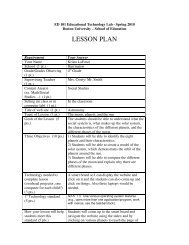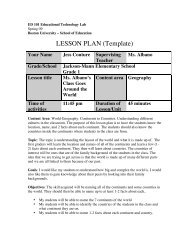Realistic Fiction Lesson Plan.pdf - ED101
Realistic Fiction Lesson Plan.pdf - ED101
Realistic Fiction Lesson Plan.pdf - ED101
- No tags were found...
Create successful ePaper yourself
Turn your PDF publications into a flip-book with our unique Google optimized e-Paper software.
Your Name Madison McEvoy Supervising Ms. GuilloryTeacherGrade/SchoolGardner Pilot Academy<strong>Lesson</strong> title <strong>Realistic</strong> <strong>Fiction</strong> Content area WritingTime of activities 9:30AM Duration oflesson/unit<strong>Lesson</strong>:Approximately 1hourUnit: 1 month1. Content Area: I will be teaching my students what realistic fiction is as well ashow to write it. I will break down the writing process into multiple sections sothat my students will be able to understand the concepts of each section.2. Topic: The students will learn how to write a realistic fiction story. They willlearn the subsets of writing stories in general, as well as important characteristicsof realistic fiction. They will also learn how to identify a realistic fiction story asopposed to other kinds of fiction stories.3. Goals: My students should be able to know the difference between internal andexternal traits as well as being able to identify whether or not a trait is internal orexternal. They should be able to describe the order in which a story is written.They should understand what the setting of a story is and they should be able tocreate a setting for a story. They should be able to take the information learnedabout internal and external traits and apply them to characters so that their storiesbecome more detailed. They should be able to create a problem and the solutionto that problem and apply that to their story. They should also be able to create asolid ending to their story. They should be able to identify the difference betweenfiction and fantasy. Overall, they should be able to write a creative and orderlyrealistic fiction story.4. Objectives:a. My students will be able to distinguish between fiction and fantasy.b. My students will be able to apply character traits to their characters intheir stories.c. My students will be able to identify which section of their story are theintroduction, the climax, and the conclusion.d. My students will be able to construct a story map as an outline for theirstory.e. My students will be able to differentiate between internal and externaltraits.f. My students will be able to create their own realistic fiction story with thehelp of this lesson.5. Technology, materials, and aids: The technology needed for this lesson includesone computer and one projector to operate my website(http://ed101.bu.edu/StudentDoc/current/<strong>ED101</strong>fa09/mmcevoy/). Worksheets
left, I will scroll all the way down to the bottom of the Story Mappingpage and discuss the mood. I will play a sound of a certain setting and askmy students to write down how they feel. After the Story Mapping page Iwill navigate to the <strong>Fiction</strong> vs. Fantasy page where we review thedefinition of realistic fiction and introduce the concept of fantasy. Herewe will watch two quick videos, one of realistic fiction and one of fantasy.Before watching the videos, the students will be asked to write downthings they see that are examples of realistic fiction and examples offantasy while watching the videos. After this we will have a quickdiscussion of their findings. Lastly I will evaluate them on what they havelearned in this lesson on the Quiz page. We will go through each questionas a class with the students raising their hands if they want to answer thequestion.d. Follow-Up: After the lesson I will pass out a few handouts on CharacterTraits, Story Mapping, and <strong>Fiction</strong> vs. Fantasy. They should completethese handouts for homework over the course of a week. Then they willbegin writing their own story, using the information learned from thislesson.7. Curriculum Frameworks:For Grade 5:Standard 12: <strong>Fiction</strong>Students will identify, analyze, and apply knowledge of the structure and elementsof fiction and provide evidence from the text to support theirunderstanding.Identify the elements of setting, characterization, conflict, and plot structure.Identify personality traits of characters, and how their thoughts, words, andactions, reveal their personalities.Describe how main characters change over time.8. Technology Frameworks:a. G3-5: 1.7 Proofread and edit writing using appropriate resources (e.g.,dictionary, spell-checker, grammar resources).i. Students can proofread and edit their realistic fiction stories.b. G3-5: 2.4 Identify ways in which technology is used in the workplaceand in society.i. Students can share their thoughts on the effectiveness of using mywebsite for this lesson.c. G3-5: 3.3 Evaluate Internet resources in terms of their usefulness forresearch.i. Students can evaluate my website as a resource for writing theirrealistic fiction stories.
Assessment:1) Which of the following is an internal trait?a) Doctorb) Americanc) Curious2) Which of the following is an external trait?a) Determinedb) Tallc) Cheerful3) Which of the following make up the setting?a) Time and Placeb) Problem and Solutionc) Ending4) Which of the following is the correct order of a story map?a) Climax, Ending, Beginningb) Beginning Climax, Endingc) Climax, Beginning, Ending5) Which of the following is an example of realistic fiction?a) Yesterday I was riding my bike to school and I got lost. After askingfor directions, I finally found my way.b) Yesterday I was riding my bike to school and I got lost. A tree told methat I should make a right at the next stop sign.c) Yesterday I was riding my bike to school and I got lost. I asked a man fordirections and he waved his magic wand and showed me the way.



